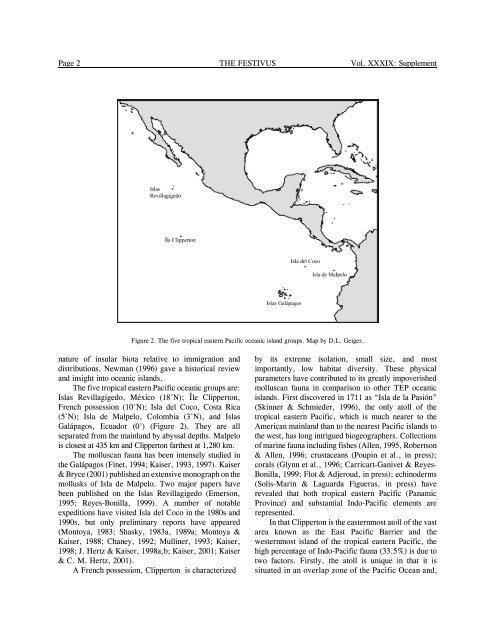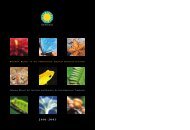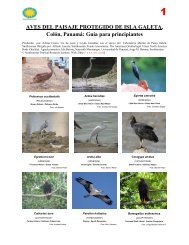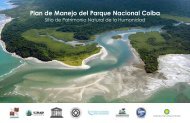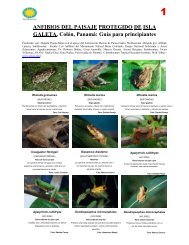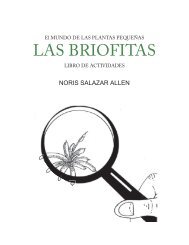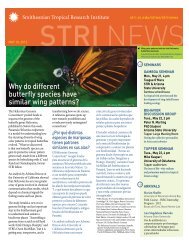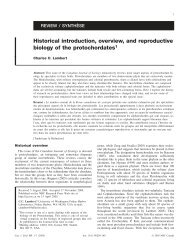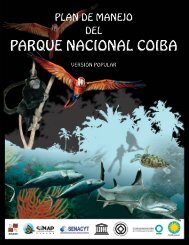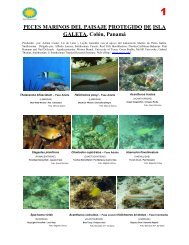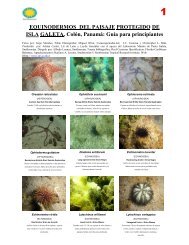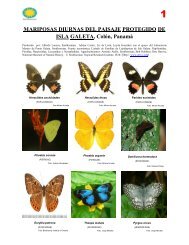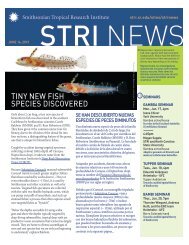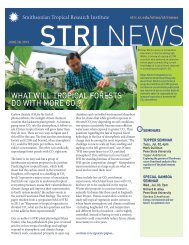Download - Smithsonian Tropical Research Institute - Smithsonian ...
Download - Smithsonian Tropical Research Institute - Smithsonian ...
Download - Smithsonian Tropical Research Institute - Smithsonian ...
Create successful ePaper yourself
Turn your PDF publications into a flip-book with our unique Google optimized e-Paper software.
Page 2 THE FESTIVUS Vol. XXXIX: Supplement<br />
Figure 2. The five tropical eastern Pacific oceanic island groups. Map by D.L. Geiger.<br />
nature of insular biota relative to immigration and<br />
distributions, Newman (1996) gave a historical review<br />
and insight into oceanic islands.<br />
The five tropical eastern Pacific oceanic groups are:<br />
Islas Revillagigedo, México (18/N); Île Clipperton,<br />
French possession (10/N); Isla del Coco, Costa Rica<br />
(5/N); Isla de Malpelo, Colombia (3/N), and Islas<br />
Galápagos, Ecuador (0/) (Figure 2). They are all<br />
separated from the mainland by abyssal depths. Malpelo<br />
is closest at 435 km and Clipperton farthest at 1,280 km.<br />
The molluscan fauna has been intensely studied in<br />
the Galápagos (Finet, 1994; Kaiser, 1993, 1997). Kaiser<br />
& Bryce (2001) published an extensive monograph on the<br />
mollusks of Isla de Malpelo. Two major papers have<br />
been published on the Islas Revillagigedo (Emerson,<br />
1995; Reyes-Bonilla, 1999). A number of notable<br />
expeditions have visited Isla del Coco in the 1980s and<br />
1990s, but only preliminary reports have appeared<br />
(Montoya, 1983; Shasky, 1983a, 1989a; Montoya &<br />
Kaiser, 1988; Chaney, 1992; Mulliner, 1993; Kaiser,<br />
1998; J. Hertz & Kaiser, 1998a,b; Kaiser, 2001; Kaiser<br />
& C. M. Hertz, 2001).<br />
A French possession, Clipperton is characterized<br />
by its extreme isolation, small size, and most<br />
importantly, low habitat diversity. These physical<br />
parameters have contributed to its greatly impoverished<br />
molluscan fauna in comparison to other TEP oceanic<br />
islands. First discovered in 1711 as “Isla de la Pasión”<br />
(Skinner & Schmieder, 1996), the only atoll of the<br />
tropical eastern Pacific, which is much nearer to the<br />
American mainland than to the nearest Pacific islands to<br />
the west, has long intrigued biogeographers. Collections<br />
of marine fauna including fishes (Allen, 1995, Robertson<br />
& Allen, 1996; crustaceans (Poupin et al., in press);<br />
corals (Glynn et al., 1996; Carricart-Ganivet & Reyes-<br />
Bonilla, 1999; Flot & Adjeroud, in press); echinoderms<br />
(Solis-Marin & Laguarda Figueras, in press) have<br />
revealed that both tropical eastern Pacific (Panamic<br />
Province) and substantial Indo-Pacific elements are<br />
represented.<br />
In that Clipperton is the easternmost atoll of the vast<br />
area known as the East Pacific Barrier and the<br />
westernmost island of the tropical eastern Pacific, the<br />
high percentage of Indo-Pacific fauna (33.5%) is due to<br />
two factors. Firstly, the atoll is unique in that it is<br />
situated in an overlap zone of the Pacific Ocean and,


